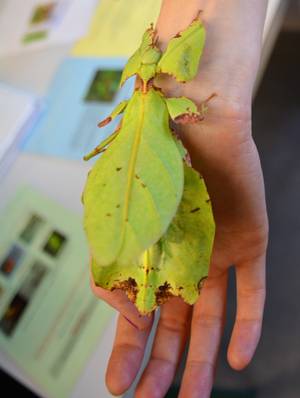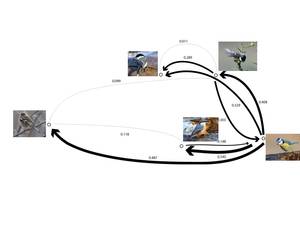Research Interests

Didactic questions deal with teaching and learning in biology, predominantly in a school context. Therefore quantitative surveys, mostly in an experimental field setting, play a major role. In my research, I focus on the effectiveness of extracurricular learning locations, experiments, living organisms and emotions in the classroom.
Exemplary Publications:
Gläser-Zikuda, M., Fuß, S., Laukenmann, M., Metz, K., & Randler, C. (2005): Promoting students’ emotions and achievement – Instructional design and evaluation of the ECOLE approach. Learning & Instruction 15: 481-495.
Hummel, E. & C. Randler (2012): Living animals in the classroom – a meta-analysis on learning outcome and a treatment-control study focusing on knowledge and motivation. Journal of Science Education and Technology 21: 95-105.
Randler, C., P. Wüst-Ackermann, C. Vollmer & E. Hummel (2012): The relationship between disgust, state-anxiety and motivation during a dissection task. Learning and Individual Differences 22: 419-424.
Borchers, C., C. Boesch, J. Riedel, H. Guilahoux, D. Ouattara & C. Randler (2014): Environmental education in Côte d’Ivoire/West Africa – Extra-curricular primary school teaching shows positive impact on environmental knowledge and attitudes. International Journal of Science Education, Part B: Communication and Public Engagement 4: 240-259.
Maier, U., N. Wolf & C. Randler (2016): Effects of a computer-assisted formative assessment intervention based on multiple-tier diagnostic items and different feedback types. Computers & Education 95: 85-98.

Beispielhafte Publikationen:
Gläser-Zikuda, M., Fuß, S., Laukenmann, M., Metz, K., & Randler, C. (2005): Promoting students’ emotions and achievement – Instructional design and evaluation of the ECOLE approach. Learning & Instruction 15: 481-495.
Hummel, E. & C. Randler (2012): Living animals in the classroom – a meta-analysis on learning outcome and a treatment-control study focusing on knowledge and motivation. Journal of Science Education and Technology 21: 95-105.
Randler, C., P. Wüst-Ackermann, C. Vollmer & E. Hummel (2012): The relationship between disgust, state-anxiety and motivation during a dissection task. Learning and Individual Differences 22: 419-424.
Borchers, C., C. Boesch, J. Riedel, H. Guilahoux, D. Ouattara & C. Randler (2014): Environmental education in Côte d’Ivoire/West Africa – Extra-curricular primary school teaching shows positive impact on environmental knowledge and attitudes. International Journal of Science Education, Part B: Communication and Public Engagement 4: 240-259.
Maier, U., N. Wolf & C. Randler (2016): Effects of a computer-assisted formative assessment intervention based on multiple-tier diagnostic items and different feedback types. Computers & Education 95: 85-98.



My current research in ornithology can be classified in the areas of behavior, evolution and ecology.

Beispielhafte Publikationen:
Randler, C. (2002): Avian hybridization, mixed pairing and female choice. Animal Behaviour 63: 103-119.
Randler, C. (2006): Red squirrels (Sciurus vulgaris) respond to alarm calls of Eurasian jays (Garrulus glandarius). Ethology 112: 411-416.
Randler, C., C. Teichmann & S. Pentzold (2010): Breeding habitat preference and foraging of the Cyprus Wheatear Oenanthe cypriaca and niche partitioning in comparison with migrant Oenanthe species on Cyprus. Journal of Ornithology 151: 113-121.
Randler, C. & M. I. Förschler (2011): Heterospecifics do not respond to subtle differences in chaffinch mobbing calls: message is encoded in number of elements Animal Behaviour 82: 725-730.
Randler, C., M. I. Förschler, J. Gonzalez, M. Aliabadian, F. Bairlein & M. Wink (2012): Phylogeography, pre-zygotic isolation and taxonomic status in the endemic Cyprus Wheatear Oenanthe cypriaca. Journal of Ornithology 153: 303-312.
Randler, C. (2012): A possible phylogenetically conserved urgency response of great tits (Parus major) towards allopatric mobbing calls. Behavioral Ecology and Sociobiology 66: 675-681.

Chronobiology deals with biological rhythms (sleep-wake behavior, chronotype) as an individual difference between humans. This feature affects a number of life-related aspects such as school performance, well-being, health, and even our sexual behavior. Until now, I have published about 100 studies on this subject, many of them with colleagues from different countries like Spain, Italy, Australia, Poland, Slovakia, Turkey, Russia, India, Iran, Mozambique and Brazil. These cooperations are inherently interdisciplinary and range from psychological to biological issues. My main research interests are children, young people and young adults, and my mission is to improve the quality of life in the widest sense.


Beispielhafte Publikationen:
Randler, C. (2007): Gender differences in morningness-eveningness assessed by self-report questionnaires: a meta-analysis. Personality and Individual Differences 43: 1667-1675.
Randler, C. (2008): Morningness-eveningness comparison in adolescents from different countries around the world. Chronobiology International 25: 1017-1028.
Randler, C. & S. Schaal (2010): Morningness-eveningness, habitual sleep-wake variables and cortisol levels. Biological Psychology 85: 14-18.
Randler, C., N. Ebenhöh, A. Fischer, S. Höchel, C. Schroff, J. C. Stoll & C. Vollmer (2012): Chronotype but not sleep length is related to salivary testosterone in young adult men. Psychoneuroendocrinology 37: 1740-1744.
Vollmer, C., F. Pötsch & C. Randler (2013): Morningness is associated with better gradings and higher attention in class. Learning and Individual Differences 27: 167-173.
Randler, C., M. B. Horzum & C. Vollmer (2014): Internet addiction and its relationship to chronotype and personality in a Turkish university student sample. Social Science Computer Review 32: 484-495.
Arbabi, T., C. Vollmer, T. Dörfler & C. Randler (2015): The influence of chronotype and intelligence on academic achievement in primary school is mediated by conscientiousness, midpoint of sleep and motivation. Chronobiology International 32: 349-357.
Tonetti, L., V. Natale & C. Randler (2015): Association between circadian preference and academic achievement: A systematic review and meta-analysis. Chronobiology International 32: 792-801.
Borchers, C., D. Ouattara, C. Vollmer & C. Randler (2015): Sleep duration and chronotype in adults in Côte d’Ivoire: influence of gender, religion and age. Journal of Psychology in Africa 25: 350–355.
Randler, C., J. F. Díaz-Morales, A. Rahafar & C. Vollmer (2016): Morningness-Eveningness and amplitude – development and validation of an improved composite scale to measure circadian preference and stability (MESSi). Chronobiology International 33: 832-848.
Randler, C., L. Wolfgang, K. Matt, E. Demirhan, M. B. Horzum & Ş. Beşoluk (2016): Smartphone addiction proneness in relation to sleep and morningness-eveningness in German adolescents. Journal of Behavioural Addictions 5(3): 465–473.
Randler, C. & A. Rahafar (2017): Latitude affects Morningness-Eveningness: evidence for the environment hypothesis based on a systematic review. Scientific Reports 7: 39976: 1-6.
